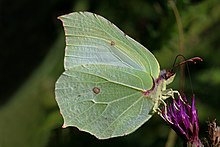| Common brimstone | |
|---|---|

| |
| Male in flight, Dry Sandford Pit, Oxfordshire | |

| |
| Female at Parsonage Moor, Oxfordshire | |
| Scientific classification | |
| Domain: | Eukaryota |
| Kingdom: | Animalia |
| Phylum: | Arthropoda |
| Class: | Insecta |
| Order: | Lepidoptera |
| Family: | Pieridae |
| Genus: | Gonepteryx |
| Species: | G. rhamni
|
| Binomial name | |
| Gonepteryx rhamni | |
| Subspecies | |
| |
| Synonyms | |
Gonepteryx rhamni, commonly named the common brimstone, is a butterfly of the family Pieridae. It lives throughout the Palearctic zone and is commonly found across Europe, Asia, and North Africa.[2] Across much of its range, it is the only species of its genus, and is therefore simply known locally as the brimstone. Its wing span size is 60–74 mm (2.4–2.9 in). It should not be confused with the brimstone moth Opisthograptis luteolata.
The brimstone relies on two species of buckthorn plants as host plants for its larvae; this influences its geographic range and distribution, as these plants are commonly found in wetlands.[3] The adult brimstone travels to woodland areas to spend seven months overwintering. In spring when their host plants have developed, they return to the wetlands to breed and lay eggs.[4] Both the larval and adult forms of the common brimstone have protective coloration and behaviour that decreases their chances of being recognised and subsequently preyed upon.[5]
The adult common brimstone has sexual dimorphism in its wing coloration: males have yellow wings and iridescence while females have greenish-white wings and are not iridescent.[6][7] This iridescence is affected by environmental factors.[2]
- ^ European red list of Butterflies. Swaay, Chris van., European Commission. Directorate-General for Environment. International Union for Conservation of Nature and Natural Resources. Blue List Programme. Luxembourg: Publications Office of the European Union. 2010. ISBN 9789279141515. OCLC 641575222.
{{cite book}}: CS1 maint: others (link) - ^ a b Cite error: The named reference
:1was invoked but never defined (see the help page). - ^ Cite error: The named reference
:2was invoked but never defined (see the help page). - ^ Cite error: The named reference
:3was invoked but never defined (see the help page). - ^ Cite error: The named reference
:112was invoked but never defined (see the help page). - ^ Wiklund, Christer; Lindfors, Virpi; Forsberg, Johan (1996). "Early Male Emergence and Reproductive Phenology of the Adult Overwintering Butterfly Gonepteryx rhamni in Sweden". Oikos. 75 (2): 227–240. Bibcode:1996Oikos..75..227W. doi:10.2307/3546246. JSTOR 3546246.
- ^ Cite error: The named reference
:15was invoked but never defined (see the help page).
